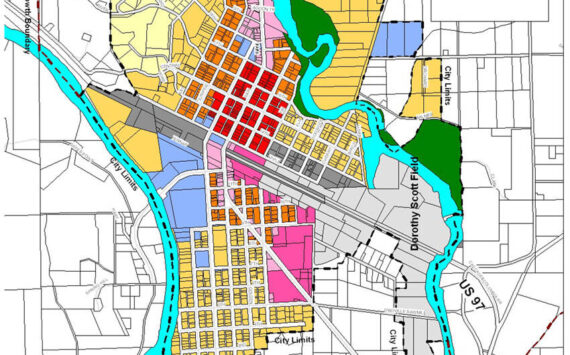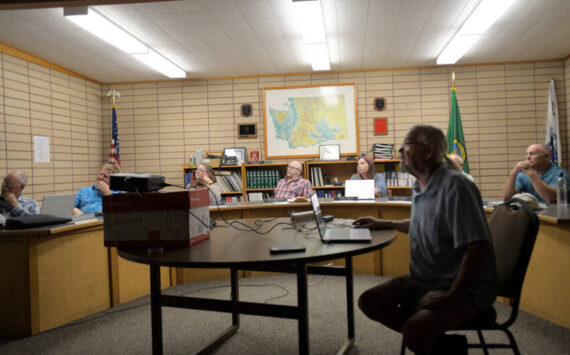Somewherealong the way certain factions have tried to sell us on the idea thathydropower is not a clean, renewable source of energy — yet every year thecycle of snow in the mountains and melt in the spring renews the waters that ourhydroelectric system turns into clean, electric power. Because of this cycleand the mighty Columbia River and its tributaries we in the Pacific Northwestfrom B.C to Oregon, are truly blessed.
Hydroelectricpower is tightly woven into our history in the North Okanogan — just look atthis week’s photograph from the Okanogan County Historical Society whichrecords the powerhouse at Toats Coulee. This powerhouse not only suppliedelectricity to the Palmer Mountain Mine, but also made Loomis one of the firsttowns in the county to have electricity. Just outside of Oroville we have historicEnloe Dam which our local PUD is trying to get back online to generate cleanenergy that we can use locally – a project that truly deserves our support.
CongresswomanCathy McMorris Rodgers held a hearing in Washington, D.C. last week about therole of hydropower in meeting current and future domestic energy needs.McMorris Rodgers is the Ranking Member of the Water and Power Subcommittee.
The hearingwas entitled “Hydropower:  Providing 75% of America’s current renewableenergy. Exploring its role as a continued source of clean, renewable energy forthe future.” 
In McMorrisRodgers’ calling for the hearing, several eye-opening facts on hydropower inthe Northwest were presented.
“Hydroelectricdams across the West and especially in Washington State have provided us withan abundant supply of clean, affordable and renewable energy,” McMorris Rodgerssays. “At a time of growing energy demand, it makes no sense to throw thisenergy source away.”
WashingtonState Senator Bob Morton, from our own seventh-district, testified at thehearing.
“Theassumption is that hydropower in the Northwest is tapped out. This isfalse. With more water storage, we could trap the thousands of acre feet ofwater from the snow that is melting right now – and turn that into hydropower,”Morton said.
Hydropoweris the largest renewable electric resource in the U.S., providing approximatelynine percent of U.S. total summer capacity, according to Avista CorporationDirector of Environmental Affairs Bruce Howard
Howardtestified, “Any adverse environmental impact of hydropower on aquatic resourceshave been substantially reduced or eliminated through the relicensing process,new and innovative technology and the application of key environmental laws.”
Alsotestifying at the hearing was Grant County PUD General Manager TimCulbertson. 
“My messagetoday is simple: there is tremendous, untapped emissions-free hydroelectricgeneration potential in the U.S.,” he said. “Too often hydropower is overlookedor taken for granted. This is an unfortunate oversight because hydropower,which does not generate any greenhouse gas emissions, is a domestic resourcethat deserves more attention as part of the nation’s renewable energy supply.”
We have tostop those that would have us believe that hydropower is not a renewableresource. It’s almost as if we have found the one successful way of generatingenergy that isn’t nasty like coal or oil and there is a faction that can’tstand that success. Everything has its issues – wind power is great – but somewill ask what about migratory birds? A giant solar array in the desert thatcould supply the whole country would be fantastic, but I’m sure someone wouldfind an endangered scorpion or tick and we’d have to shut that down to.
There arealways trade-offs, even with the seemingly most environmentally friendly plans.”Carbon footprint” is one of those buzz-phrases currently in fashion with the so-calledenvironmentalist community. As the facts listed above show hydroelectric powerkeeps the Northwest’s carbon footprint small. Yet some would have us pull damsout.
I justrecently read how the carbon footprint left behind from the building of a neweco-friendly hybrid like a Prius is greater than driving a used Honda or Geo thatgets 30 to 35 miles per gallon. The advantage of having a Prius, from a purelyenvironmental, not gas-saving standpoint, didn’t kick in until you hit the46,000 mile mark. The best laid plans of mice and men….
Withhydroelectric we can cleanly charge the electric car of the future or generatehydrogen gas to power emissions-free hydrogen vehicles. Other methods ofgenerating electricity are obviously not so clean and defeat the purpose ofhaving a hydrogen or purely electric vehicle in the first place. Yes, wehave challenges when it comes to issues of salmon and steelhead, but we’ve comea long way in addressing those issues and the alternative – pulling out dams -is unrealistic when you stop and thing about what we’d need to do to replacethose energy supplies – clean nuclear, unlikely any time soon; coal, gas oroil, I certainly hope not. Depression-erafolksinger Woody Guthrie wrote and sang,
“Roll on, Columbia, roll on
Roll on, Columbia, roll on Your power is turning our darkness to dawn So roll on, Columbia, roll on.” Thoselyrics bring back memories of singing Roll On Columbia, Roll On with myclassmates at Oroville Elementary as a young lad. I believed the words then andstill do today.







